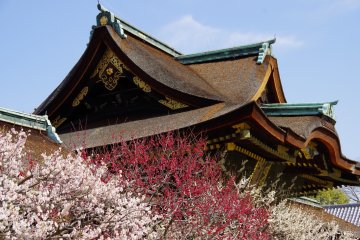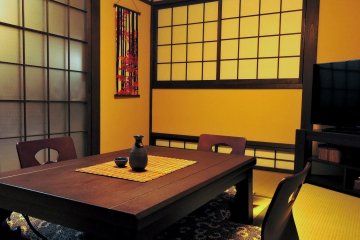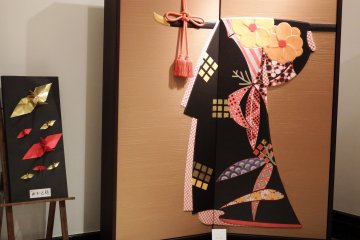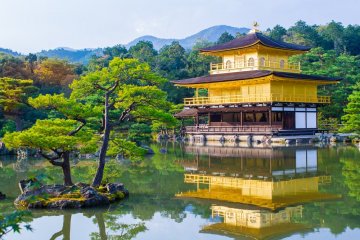

Known for its academic blessings, Kitano Tenmangu is a Shinto shrine in Kyoto’s Kamigyo ward that is dedicated to Sugawara no Michizane, an influential scholar and politician. The shrine was built in 947 AD and is Japan’s first shrine to enshrine an actual person as a deity. Although there are numerous shrines throughout Japan dedicated to Michizane who is mainly known as a god of academics, Kitano Tenmangu is the original one.
The massive Ro-mon Gate stands as the border between the city and the shrine grounds. This wooden structure, detailed with gold-and-wooden carvings, serves as an introduction to the architectural mastery ahead. Upon entering, it is customary to go to the chozuya and perform a hand-cleansing ritual. After you complete the ritual, explore the shrine’s tranquil grounds.
There are city buses running frequently from Kyoto station to the Kitano Tenman-gu-mae bus stop, which would cost you around ¥230 and will take around 30 minutes.



교토 북서부, 유명한 킨카쿠지 (금각사) 인근 키타노텐만구는 9세기 귀족 스가와라노 미치마사를 학문신으로 모시는 신사다. 매년 매화축제를 개최하고 있는 2월 25일, 경내에서 다회가 개최된다. 수백 개의 매화 속에서 인근 하나마치 (上七軒: 카미히치겐)에서 온 30여 명의 게이코(교토에서 예능에 뛰어난 사람을 부르는 이름)와 무희 (연회석에서 춤을 추는 동기)가 참배객들에게 맛차와 일본식 과자를 대접한다. 다회는 10시에 시작되어 15시 종료다. 입장료는 1,500엔 여기에는 맛차와 일본식 과자, 조품과 보물전 관람권이 포함되어 있다. 티켓은 한정 3000장이니까, 장사진을 피하기 위해 가능한 한 빨리 가자.



시조 카라스마의 호텔 닛코 프린세스 교토는 싱글 룸 (24㎡)부터 트윈 룸 (48㎡)까지 갖춘 넓적한 객실을 갖추고 있다. 호텔 스태프들은 트레이닝을 잘 받고 최고의 예절과 접대를 한다.



境町店」-67014.jpg)
"무라사키노 와쿠덴 사카이마치텐"이다. 일명 "무로마치 와쿠덴"이라고 하는 이 가게에는, 와쿠덴의 과자나 도시락등을 가지고 갈 수 있는 숍이 있지만, 그 2층, "다과석"이라고 하는 일본 카페에 준비되어 있다. 맛차와 와쿠덴의 일본식 과자. 조용하고 사치스러운 한때를 즐길 수 있다.

Well known as the Golden Pavilion, Kinkaku-ji is a three-story Zen Buddhist temple in northern Kyoto. Kinkaku-ji and Ginkaku-ji (Silver Pavilion) were built in the 13th century and were originally intended as noble villas for the Ashikaga shoguns. Today the building is also known as Rokuon-ji. Kinkaku-ji houses several important Buddhist relics and is a sacred place for the Rinzai sect of Japanese Buddhism. Each floor of the temple conveys a different architectural style. The first floor is in the Shinden style, the second floor in the Bukke style and the third floor in the Chinese Zen style. Thus became one of the most photogenic temples in all of Kyoto. The temple was once the retirement villa of the shogun Ashikaga Yoshimitsu. After his death in 1408 he wanted to give the building to the Rinzai sect as a Zen temple. The grounds of the Kinkaku-ji Temple used to consist of several other buildings, but unfortunately burned down in the fires and destruction during the Onin War in the 1400s. The building you see today was also rebuilt in 1955.

Keishunin (桂春院) is one of the sub-temples of Myoshin-ji containing gardens and a teahouse.

Ryoanji Temple is home to Japan’s most famous Zen stone garden and one of Kyoto’s most iconic scenes. Believed to be built back in the Muromachi period (14th - 16th century), the origin and designer of the garden is still unknown to this day. The stones in the garden are intentionally placed so that one cannot view all 15 stones from any one angle. The meticulous design of this karesansui (Japanese rock garden) leads many to credit the celebrated artist, Soami, as the garden’s creator—albeit unproven. The 248-square meter garden bears little trace of greenery, and is instead immaculately lined with raked white gravel. The seemingly random placement of the stones adds to the mystique of Ryoan-ji, its abstract layout leaving visitors questioning the meaning and purpose of the garden. While the garden remains a mystery, the history of Ryoanji Temple is well documented. The temple buildings were originally a Heian Period villa, and were converted into a Zen temple in 1450. Now, Ryoanji is part of the Myoshin-ji school in the Rinzai sect of Zen Buddhism. In 1994, Ryoanji’s immaculate zen stone garden was recognised as a UNESCO World Heritage Site, and is also designated as a Historic Monument of Ancient Kyoto.